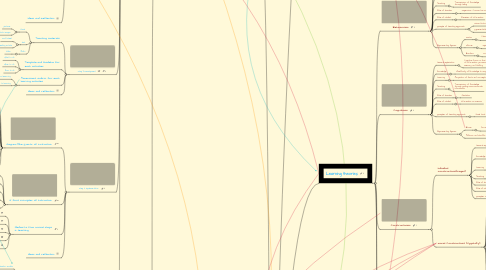
1. Instructional Design Model
1.1. From student perspective
1.1.1. RASE
1.1.1.1. Step 1 Resource
1.1.1.2. Step 2 Activity
1.1.1.3. Step 3 Support
1.1.1.4. Step 4 Evaluation
1.1.2. Agile
1.2. From planner perspective
1.2.1. ADDIE
1.2.1.1. Step 1 Analysis
1.2.1.1.1. Learner Analysis
1.2.1.1.2. Task analysis
1.2.1.1.3. Context analysis
1.2.1.1.4. Ideas and Reflections
1.2.1.2. Step 2 Design
1.2.1.2.1. Learning objectives
1.2.1.2.2. Instructional method
1.2.1.2.3. Storyboard
1.2.1.2.4. Ideas and Reflection
1.2.1.3. Step 3 Development
1.2.1.3.1. Teaching materials
1.2.1.3.2. Template and Guideline for each activities
1.2.1.3.3. Assessment Rubric for each learning activities
1.2.1.3.4. Ideas and reflection
1.2.1.4. Step 4 Implementation
1.2.1.4.1. Gagne's Nine Events of instruction
1.2.1.4.2. 5 first Principles of Instruction
1.2.1.4.3. Herbart's Five normal steps in teaching
1.2.1.4.4. Ideas and reflection
1.2.1.5. Step 5 Evaluation
1.2.1.5.1. General Program Evaluation
1.2.1.5.2. Technology Evaluation
1.2.1.5.3. Ideas and reflection
1.2.2. Assure
1.2.2.1. Step 1 Analysis Learner
1.2.2.2. Step 2 State objectives
1.2.2.3. Step 3 Select methods, media or materials
1.2.2.4. Step 4 Utilise media and materials
1.2.2.5. Step 5 Require learner's partipation
1.2.2.6. Step 6 Evaluation and Review
2. Integrating technology into instructional design
2.1. History of instructional technology
2.2. Use of technology in implementing teaching and learning in classroom
2.2.1. Computers
2.2.1.1. Types of computer
2.2.1.1.1. Desktop (Notebook)
2.2.1.1.2. Portable (Laptop)
2.2.1.2. Functions of computers in implementing teaching and learning
2.2.1.2.1. Implementing visual learning activities eg. Searching pictures, video and online databases
2.2.2. Website
2.2.2.1. Tools for making website
2.2.2.1.1. Adobe Dream Weaver
2.2.2.1.2. Coffee Cup
2.2.2.1.3. MaCow
2.2.2.1.4. Wix
2.2.2.1.5. Google sites
2.2.2.2. Functions of developing websites in implementing teaching and learning
2.2.2.2.1. Onlline assignment
2.2.2.2.2. Online Quiz
2.2.2.2.3. Assign reading materials and video
2.2.3. Mobile Devices
2.2.3.1. The use of App
2.2.3.1.1. Types of App
2.2.3.1.2. Advantages of using app in implementing teaching and learning
2.2.4. Multmedia resources
2.2.4.1. Online media
2.2.4.1.1. Examples of online media
2.2.4.1.2. Advantages of using online media in implementing teaching and learning
2.3. Ideas and Reflection
2.3.1. Teaching approach
2.3.2. Selection of teaching materials
2.3.3. Implementation
3. flipped learning
3.1. Four Pillars of Flipped learning
3.1.1. Flexible Environment
3.1.2. Learning Culture
3.1.3. Intentional Content
3.1.4. Professor Educatior
3.2. The nature of flipped learning
3.3. Benefits of flipped learning
3.4. Ideas and reflection
4. e-learning
4.1. Theoretical framework for e-learning
4.1.1. Theory-based design framework ( N. Dabbagh)
4.1.1.1. Instructional Strategies
4.1.1.2. Learning Technologies
4.1.1.3. Pedagogical Models or Constructs
4.1.2. Technology Acceptance Model (A.A.Davies)
4.1.2.1. Perceived Usefulness of E-learning
4.1.2.2. Perceived ase of use influence
4.1.2.3. Influence student intention to use e-learning system
4.1.3. The funnel model (0.Willis)
4.1.3.1. Materials Development & Instructional Design
4.1.3.2. Technology & Delievery
4.1.3.3. Governance &Finance
4.1.4. Ideas and reflections
5. Learning theories form instructional design perspective
6. Current development trend of instructional design and technology
6.1. Ideas and Reflections
7. Learning theories
7.1. Behaviorism
7.1.1. General explaiination
7.1.1.1. Behaviorism operates on an principle of stimulus-response. Learning behaviors are caused by external stimulus.
7.1.2. Knowledge
7.1.2.1. Knowledge regard as fixed body to acquire
7.1.3. Learning
7.1.3.1. Acquisition of facts ,skills and concepts
7.1.4. Teaching
7.1.4.1. Transmission of knowledge through telling
7.1.5. Role of teacher
7.1.5.1. Supervisor: Correct wrong answers
7.1.6. Role of student
7.1.6.1. Receiver of information
7.1.7. Example of teaching approach
7.1.7.1. Diirect Instruction
7.1.7.2. Experiential learning
7.1.8. Representing figures
7.1.8.1. Pavlov
7.1.8.1.1. Classical conditioning
7.1.8.2. Skinner
7.1.8.2.1. Operant Conditioning
7.1.8.3. Bandura
7.1.8.3.1. Social learning theory
7.2. Cognitivism
7.2.1. General explaination
7.2.1.1. Cognitive focus on the inner mental process of information process include thinking, memory and thinking
7.2.2. Knowledge
7.2.2.1. Fixed body of knowledge to acquire
7.2.3. Learning
7.2.3.1. Acquisition of facts and concepts
7.2.4. Teaching
7.2.4.1. Transmission of knowledge through guiding more accurate information
7.2.5. Role of teacher
7.2.5.1. Faciliator
7.2.6. Role of student
7.2.6.1. Information Processor
7.2.7. Examples of teaching appraoch
7.2.7.1. Visual tools stimulation
7.2.7.1.1. Digital
7.2.7.1.2. Graphics
7.2.7.1.3. Charts
7.2.8. Representing figures
7.2.8.1. Bloom
7.2.8.1.1. Knowledge Taxonomy
7.2.8.2. Atkinson and Shriffin
7.2.8.2.1. Information processing theory
7.3. Constructivism
7.3.1. Individual constructivist(Piaget)
7.3.1.1. General explaination
7.3.1.1.1. Knowledge is constructed by individual's previous knowledge and experience
7.3.1.2. Knowledge
7.3.1.2.1. Changing body of knowledge through individual constructed and reconstructed
7.3.1.3. Learning
7.3.1.3.1. Active construction and re construction of prior knowledge
7.3.1.4. Teaching
7.3.1.4.1. Challenging and asking learner questions
7.3.1.5. Role of teacher
7.3.1.5.1. Facilitator
7.3.1.6. Role of Student
7.3.1.6.1. Active knowledge constructor
7.3.1.7. Examples of teaching approach
7.3.1.7.1. Discovery learning
7.3.2. Social Constructivist (Vygotsky)
7.3.2.1. General explanation
7.3.2.1.1. Social culture and languages are two essential sources on affecting individual's knowledge construction
7.3.2.2. Knowledge
7.3.2.2.1. Social constructed concepts which influenced by culture, language, beliefs and context
7.3.2.3. Learning
7.3.2.3.1. collaborative construction of knowledge and values among peers and teachers
7.3.2.4. Teaching
7.3.2.4.1. Teachers and student co-constructing knowledge
7.3.2.5. Role of teacher
7.3.2.5.1. Facilitator and co-construct knowledge with students
7.3.2.6. Role of student
7.3.2.6.1. Active knowledge co-constructor
7.3.2.7. Examples of teaching approach
7.3.2.7.1. Collaborative learning,
7.3.2.7.2. Inquiry learning
7.3.2.8. Ideas and Reflection
7.4. Humanism
7.4.1. General explaination
7.4.1.1. Humanism regards learning as a person act to fulfill one's potential
7.4.2. Knowledge
7.4.2.1. Knowledge regards as lifelong skills
7.4.3. Learning
7.4.3.1. Learning occur because individual is innately ambitious and drive his/her rewards from achievement
7.4.4. Teaching
7.4.4.1. Enriching student's potentials in all round
7.4.5. Role of teacher
7.4.5.1. Facilitator, lifelong tutor
7.4.6. Role of student
7.4.6.1. Lifelong learner
7.4.7. Examples of teaching approach
7.4.8. Representing figures
7.4.8.1. Kolb
7.4.8.1.1. Experiential learning
7.4.8.2. Maslow
7.4.8.2.1. Hierarchy needs
7.4.8.3. Rogers
7.4.8.3.1. Narrative therapy
7.5. Ideas and Reflections
8. Concept of instructional design
8.1. Definition
8.2. Instructional designer
9. The role of instructional designer
10. Rationale of this mindmap
11. Structure of this mindmap
12. Aims of the course MITE 6330
13. Learning Design
13.1. 7CS Learning design model
13.1.1. view it as cycle
